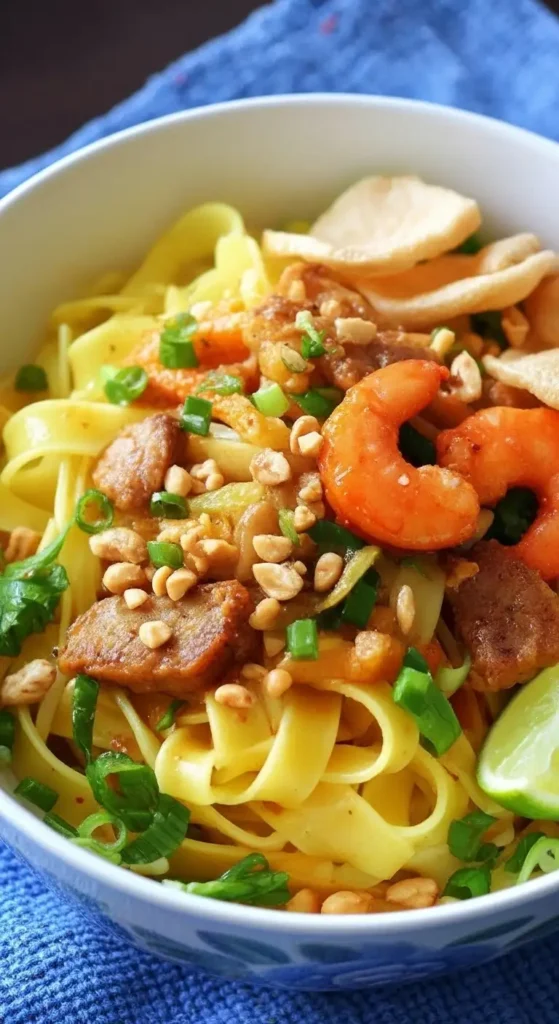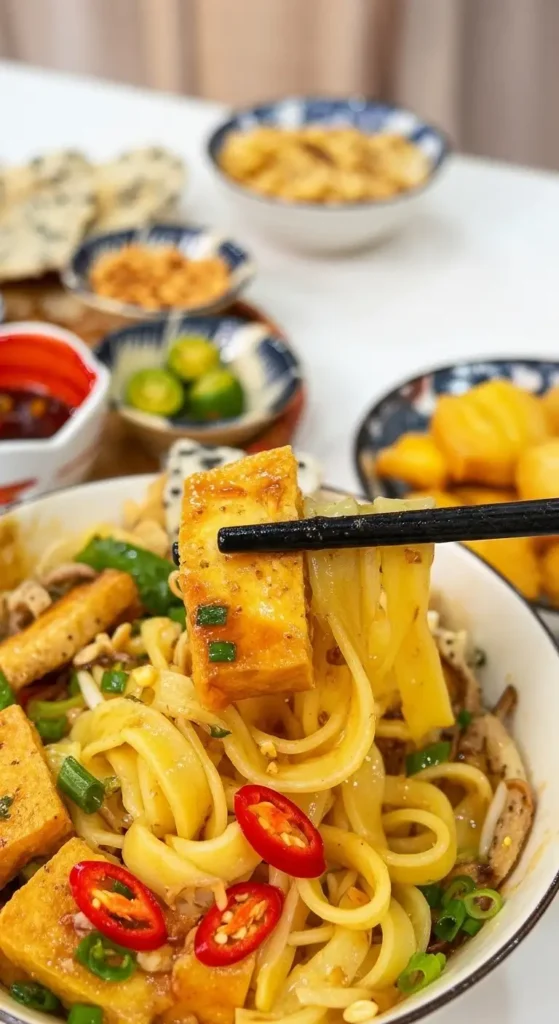Mì Quảng: The Basics
Mì Quảng, which literally translates to “Quảng-style noodles,” is distinguished by several key components:
The Noodles: The star of the dish, these are wide, flat rice noodles, often given a signature yellow tint with a touch of turmeric and sometimes coated with peanut oil to keep them from sticking. They are thicker and chewier than phở noodles.
The Broth (Nước Lèo): Unlike other Vietnamese noodle soups that are drowning in broth, Mì Quảng is served with only a small amount of richly flavored, concentrated broth. This broth, simmered from pork bones, shrimp, and sometimes chicken, is thick, intensely savory, and seasoned with fish sauce, shallots, and turmeric. It’s meant to coat the noodles and toppings, not fully submerge them.
Essential Toppings: A traditional bowl features a medley of proteins—typically pork slices, shrimp, and a boiled quail egg or half of a hard-boiled chicken egg.
Garnish and Crunch: The dish is finished with fragrant garnishes like chopped scallions and cilantro, a generous sprinkle of roasted peanuts, and is served with a large, crispy, toasted sesame rice cracker (bánh tráng mè).
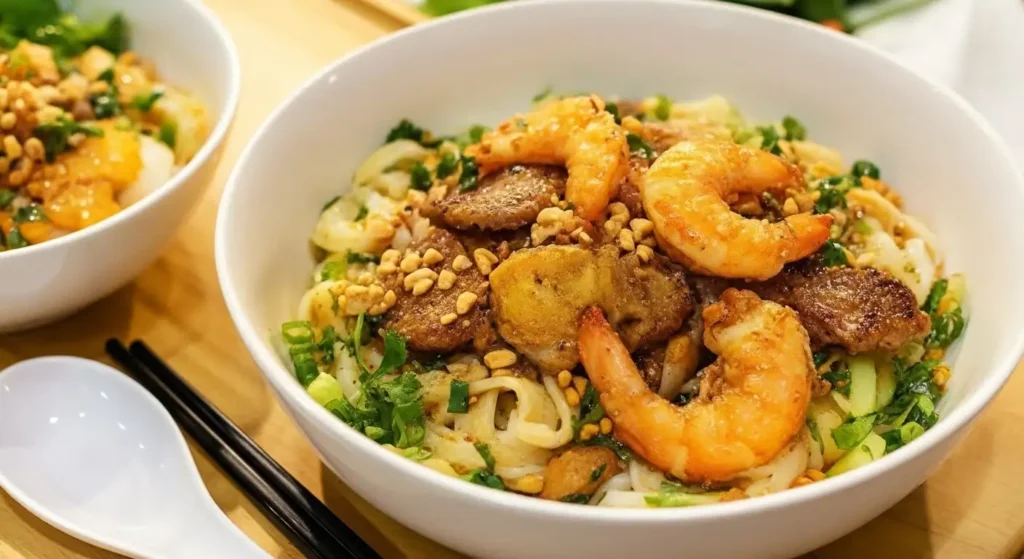
Variations: The Different Kinds of Mì Quảng
Mì Quảng is versatile, with the name often changing based on the main protein used.
| Vietnamese Name | English Name | Key Protein/Feature | Note |
|---|---|---|---|
| Mì Quảng Tôm Thịt | Shrimp and Pork Mì Quảng | Shrimp, Pork (the classic and most common) | The benchmark version, combining seafood and land proteins. |
| Mì Quảng Gà | Chicken Mì Quảng | Chicken | Often made with tender bone-in or boneless chicken pieces. |
| Mì Quảng Ếch | Frog Mì Quảng | Frog Legs | A unique and popular local delicacy; the frog is often intensely marinated. |
| Mì Quảng Cá Lóc | Snakehead Fish Mì Quảng | Flaky Snakehead Fish | Common in coastal areas, offering a delicate flavor. |
| Mì Quảng Sườn | Pork Rib Mì Quảng | Pork Ribs | Features meaty, slow-cooked pork ribs for a rich flavor. |
| Mì Quảng Chay | Vegetarian Mì Quảng | Tofu, Mushrooms, Vegetables | A meatless version for vegetarians. |
How to Eat Mì Quảng
The proper way to enjoy Mì Quảng is to mix all the elements to ensure every bite is a blend of flavors and textures.
Prep the Greens: Your bowl will typically come with a bed of fresh herbs and shredded vegetables on top or a separate plate on the side. This often includes shredded banana blossom, lettuce, basil, and cilantro. Add the herbs and shredded veggies into your bowl.
Add Condiments: Squeeze a wedge of lime over the bowl for acidity, and add chili paste/oil or fresh sliced chilies to your desired level of heat. A dash of fish sauce is sometimes added, though the broth is already strong.
Mix Everything: Use your chopsticks and spoon to mix all the ingredients thoroughly—the noodles, the meat, the broth, and the fresh vegetables. This is crucial as it ensures the concentrated broth and toppings fully coat the noodles.
Crunch and Enjoy: Break the large, sesame rice cracker into small pieces and add them to your bowl. Eat the noodles, meat, and vegetables, making sure to scoop up some of the rich broth and crunchy peanuts with each mouthful. The crispy cracker provides a satisfying textural contrast to the soft noodles and tender meat.
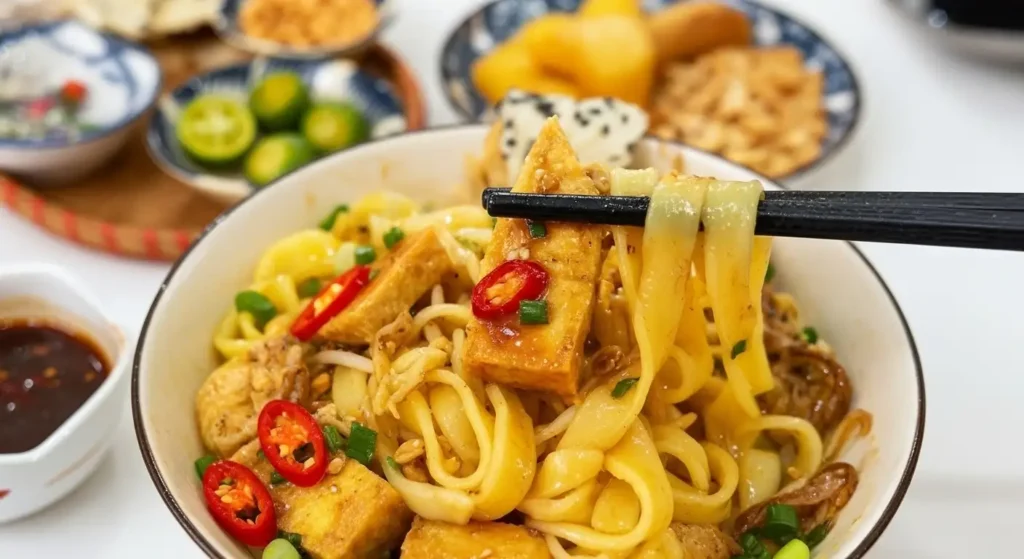
Regional Differences in Vietnam
While Mì Quảng is a Central Vietnamese dish, subtle differences exist as it travels from its birthplace.
Central Vietnam (Quảng Nam/Da Nang/Hoi An) - The Authentic Style
Broth: Highly concentrated, rich, and savory with turmeric for color. It’s truly a sauce, just enough to coat the ingredients.
Noodles: Wide, flat, rice-based, often yellow from turmeric.
Accouterments: Served with a wide variety of fresh herbs and the mandatory large, sesame rice cracker (bánh tráng mè) and plenty of crushed peanuts. This region places the strongest emphasis on the fresh herbs.
Southern Vietnam
Broth: The broth tends to be sweeter, sometimes slightly lighter in flavor, and they are more generous with the amount of broth in the bowl, making it closer to a typical noodle soup.
Toppings: May include extra ingredients common in Southern cuisine, and the flavor profile is generally less spicy and less intensely savory than the Central version.
Presentation: Often features more bean sprouts and different herbs compared to the traditional Central style.
Northern Vietnam
Presence: Mì Quảng is less common in the North compared to the Central and South.
Broth: When available, the Northern palate favors a more frugal and balanced flavor. The broth may be lighter, less sweet, and the overall dish less spicy, reflecting the characteristic Northern style of cuisine.
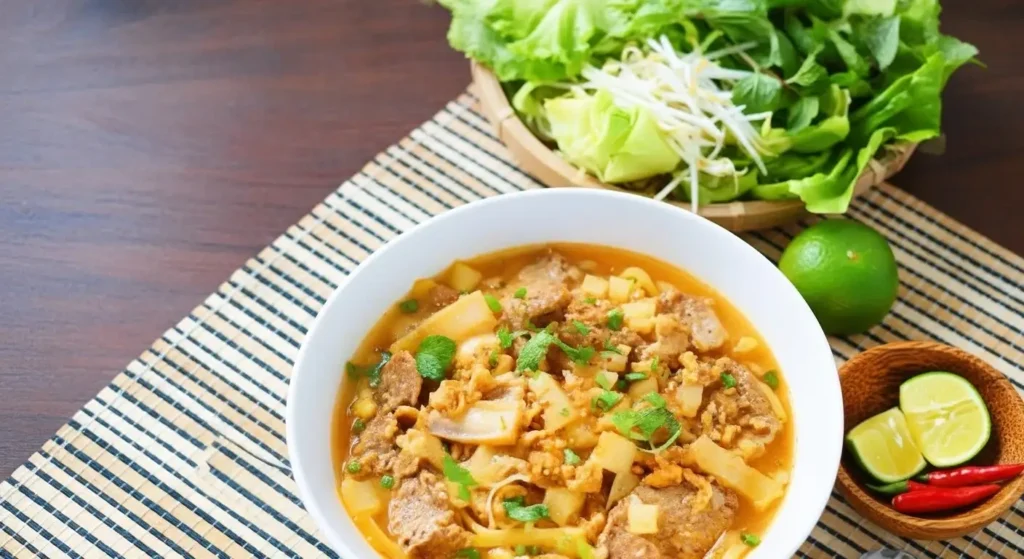
Highly Rated Mì Quảng Restaurants
If you’re looking for an authentic and high-quality bowl, these restaurants in the dish’s birthplace consistently receive high praise from locals and tourists alike, with strong Google Maps reviews (generally 4.0+ stars):
In Da Nang
My Quang Ba Mua (95A Đ. Nguyễn Tri Phương, Thạc Gián, Thanh Khê, Đà Nẵng 550000, Vietnam)
One of the most famous and largest chains, often recommended for first-time visitors, offering a full range of toppings (chicken, frog, beef, shrimp/pork).
Mì Quảng Ếch Bếp Trang (441 Ông Ích Khiêm, Phước Ninh, Hải Châu, Đà Nẵng 550000, Vietnam)
Highly recommended for its signature Frog Mì Quảng (Mì Quảng Ếch), served in a unique ceramic pot.
Mỳ Quảng Cô Sáu (397 Đ. Trần Hưng Đạo, An Hải Trung, Sơn Trà, Đà Nẵng 550000, Vietnam)
A local favorite that has even been recognized in the MICHELIN Guide, known for its authentic flavor and consistent quality.
In Hoi An
Mì Quảng Ông Hai (6A Trương Minh Lượng, Cẩm Châu, Hội An, Quảng Nam 560000, Vietnam)
Widely regarded as one of the best places to try an authentic Hoi An style Mì Quảng, known for its traditional preparation.
Mì Quảng 92 (112A Đ. Trần Cao Vân, Phường Minh An, Hội An, Quảng Nam, Vietnam)
A high-rated, local gem in Hoi An celebrated for its authentic Central Vietnamese noodles, especially the unique and popular Snakehead Fish (Cá Lóc) variation.


